So it occurred to me as I started to work on blogging my way through the third Marston Wonder Woman that I wasn’t really sure when to stop. That is, what was the last issue of WW that Marston wrote? I know he died in 1947…but I haven’t been able to find anyone to tell me the number of his final issue. The problem is compounded by the fact that I think DC kept labeling the books as Marston-penned for some time after his death. So…anyone out there know which was his final effort?
_____________
Anyway, while fruitlessly trying to determine when I could lay this burden down, I did find some juicy Marston quotes:
“The only hope for peace is to teach people who are full of pep and unbound force to enjoy being bound … Only when the control of self by others is more pleasant than the unbound assertion of self in human relationships can we hope for a stable, peaceful human society. … Giving to others, being controlled by them, submitting to other people cannot possibly be enjoyable without a strong erotic element”.
“Tell me anybody’s preference in story strips and I’ll tell you his subconscious desires…Superman and the army of male comics characters who resemble him satisfy the simple desire to be stronger and more powerful than anybody else. Wonder Woman satisfies the subconscious, elaborately disguised desire of males to be mastered by a woman who loves them.”
“I am one of those odd, perhaps unfortunate men who derive an extreme erotic pleasure from the mere thought of a beautiful girl chained or bound…Have you the same interest in bonds and fetters that I have?”
That last one was apparently from a letter Marston wrote to William Gaines. To which Gaines replied (and this is a direct quote) — “Oy.”
I also found out that Marston apparently hand-picked Harry G. Peter over the objections of his editor, Sheldon Mayer. Marston liked Peter’s mix of innocence and sensuality, it sounds like. Mayer felt Peter was too old-fashioned. Score another one for Marston.
_______________
Enough shilly-shallying. Let’s see that cover to #3:
I think that’s the best cover so far, actually. Completely insane juxtaposition of fantasy chariot and big honking disembodied head. And the colors! Saturated orange sky, gaudy green bubbles — Wonder Woman’s ridiculous red and blue suit is rendered relatively sedate in comparison. (Who did the color on these books, I wonder? Does anyone know?) That giant curvy eyebrow on the floating face is worth the price of admission alone, I think. Or the dragon-entwined cigarette holder; or the sledding cherubs, Or the incredibly expressive, frilly lines making up the horse’s leg.
Did I mention that I love Peter?
Also, notice that WW apparently went to bi-monthly with this issue. The book must have been selling well. Coming out six times a year, that means Peter must have been banging out about a page a day for just this title alone, plus what I presume was a comparable amount of work for Sensation Comics. So…two pages a day? That’s a pretty serious workload.
As far as the plot goes, this issue is devoted to a battle against, and the ultimate conversion of Nazi agent Baroness Paula von Gunther. Wikipedia informs me that the Baroness was knocking around for a while before this issue, showing up on several occasions in Sensation Comics, and on one occasion plotting to monopolize the American milk supply so that U.S. citizens would have weak bones and be unable to defeat Hitler’s stronger-boned armies. She also showed up in a fairly unmemorable adventure in Wonder Woman #1, where she appears to have been drowned. But (as is the way with the super-villains) it didn’t take, and she’s back now.
The first chapter is easily the best. Paradise Island seems always to fire Marston’s, um, imagination. This was a Christmas issue, I think…but of course, the Amazons don’t celebrate Christmas, because they’re pagans. Instead, they celebrate a solstice festival called Diana’s Day. Diana’s Day rituals include gift giving…and, to no one’s surprise, also masquerade and bondage. Oh, yes, and dressing up as deer to be hunted, hog-tied, and ritually fake-eaten.
“You make my mouth water. How about feeding me to myself?” Not really much to add to that.
One of the things this chapter really brought home to me was the extent to which Paradise Island functions as a kind of gay utopia; defined by some clueless straight guy as “an imaginary future in which gender, sexuality, and identity are fluid and in which pleasure is unregulated by either external or internal censors. It’s a place where taboos dissolve and sublimation vanishes; every relationship is erotic, every action sensual.” Paradise Island is literally paradise; it’s prelapsarian. The knowledge of good and evil, of shame, is suspended. The women on Paradise Island don’t behave like grown women; they behave like polymorphously perverse children. They love gifts; they throw themselves bodily into play and pretend; they have no particular inhibitions.
They’re innocents — but innocence here is charged with eroticism. They haven’t fallen, so they don’t perceive sex as sin, which means that anything goes (or is, at least, implied, this being an all-ages title.)
In particular, not having fallen means that the incest taboo is repealed. Radical feminist Shulamith Firestone (writing some time after Marston) argued that without the incest taboo
adults might return within a few generations to a more natural “polymorphously perverse” sexuality, the concentration on genital sex and orgasmic pleasure giving way to total physical/emotional relationships that included that. Relations with children would include as much genital sex as the child was capable of…. Adult/child and homosexual sex taboos would disappear, as well as nonsexual friendships…. All close relationships would include the physical, our concept of exclusive physical partnerships (monogamy) disappearing from our psychic structure as well as the construct of a Partner Ideal.
For Firestone, getting rid of the patriarchal law would eliminate hierarchy; prejudice and authority would dissolve in a warm polymorphous rush. Marston’s vision is analagous, even if he doesn’t exactly see the law disappearing. Rather, he wants the law of the father replaced with the law of the mother; force replaced with “loving obedience” (a term I’m pretty sure I’ve seen him use a couple of times.) Aphrodite’s rule (and by extension Hippolyta’s rule) over Paradise Island is a mother’s rule. But more than that, *all* the relationships on Paradise Island are essentially eroticized mother/daughter relationships. Wonder Woman sitting in a compromising position on Hippolyta’s lap is the blueprint for how all the Amazon’s relate to each other; maternal sentiment bleeding over into eroticism.
Everybody gets to be lovingly obedient and to enforce loving obedience. It’s all daughters playing at being mothers playing at being daughters, sending each other to their rooms — or, you know, to their bonds. Or whatever.
The charged mother worship here is analagous to that in Tabico’s awesomely squicky story “Adaptation”, in which an alien female insect implants mind-controlling larvae in human hosts, precipitating an escalating mother-love apocalypse of incestuous, cross-species prelapsarian obedience and abjection. (The story is both extremely X-rated and viscerally disgusting…we’re talking sex with bugs here, people. Explicit sex with bugs. So, don’t say I didn’t warn you.)
Update: Tabico’s not a widely known author, but I explain at length why you should care about her (or why I do, anyway) at the end of this essay.
And, as in Tabico’s story, when mother love dissolves the Law — you don’t have the law. Babies don’t worry about good vs. evil; they think about what feels right and what they need. Tabico is rooting for the insects…and while Marston isn’t exactly rooting for the Nazis, I think it’s safe to say that he isn’t exactly unsympathetic to the Baroness either.
In fact, in terms of the erotic economy of this first story, the Baroness and her minions serve exactly the same funciton as the Amazons themselves. According to the plot, the Baroness has sent one of her slaves, Keela, to Paradise Island to cause mischief. Keela infiltrates the Amazons, ties up Etta Candy (who’s visiting for Diana’s Day) and steals Hippolyta’s girdle, which makes its wearer invulnerable. This allows her to wrestle with and defeat Wonder Woman.
The point here is that Keela acts basically exactly like the Amazons she is supposedly infiltrating. That is, she plays the same bondage games in much the same way:
In theory, of course, the Amazons are “just playing” while Keela is in earnest. But surely, the extra earnestness is just a way to increase the erotic charge — and a way, moreover, to put Wonder Woman in a position of submission as well as in a position of dominance. The theft of the girdle gives Keel the power of the mother, who overpowers WW. And then, inevitably, Etta and WW come right back and overpower and control her.
Etta’s fat, as she says, but she gets to participate in the orally erotic mother/daughter back and forth too…as does even Paul von Gunther herself, who the Amazons capture and imprison at the end of the story…only to let her escape immediately. One suspects that they did it on purpose; the play’s the thing, after all, and a mother tied up is no fun unless she can come right back and tie you up as well.
In any case, in the second story in the comic, the Baroness is free…which gives WW the chance to interrogate her slaves using a Brain Detector (a magically more efficient version of the lie detector machines Marston helped develop.) You’d think WW would just use her lasso to command them to tell her what they know…but obviously the machine is fun too…pretty girls hooked up to wires and forced to confess…oh, yes, that’s quite nice….
Ahem.
Oh, by the by, the Baroness’ slaves not only do everything she commands, but they also refuse to be taken out of their chains because they just love being dominated so much. (The Amazons, of course, also wear their bracelets as a symbol of subservience. But they are subservient to a good mother, you see, while the Baroness’ slaves are subservient to a bad mother. It’s much different. No, really.)
Anyway, there’s also a bunch of hoo ha with the Baroness turning various things invisible with some kind of ray (Marston had a thing for invisibility too…and no, I don’t know what was up with that.) Eventually we learn that the Baroness has corrupted Steve Trevor and turned him into a slave as well, which is very broadminded of her, since she seems to generally prefer female thralls.
(One of the ways that WW figures out that Steve is not quite right, incidentally, is that he starts to make eyes at Diana Prince and totally ignores Wonder Woman. I just wanted to point out in passing that the whole love triangle thing with Steve-Diana-WW has never yet seemed anything but tacked on. Diana never actually seems put out, WW and Steve seem completely an item; the whole Diana identity seems more like a way to further humiliate/mock Steve than an actual excuse for melodrama. Don’t get me wrong; it’s kind of fun as an excuse to mock Steve…it just seems very much a leftover from somebody else’s concept. Basically, I think the double-identity thing is a very natural metaphor for masculine identity, but doesn’t really have as much resonance for female identity. Or, at least, it probably could have resonance in a story about women, but Marston wasn’t sufficiently interested in it, it doesn’t seem, to move it away from the Clark Kent/Superman roots in any very interesting way.)
So, to free Steve, WW lets herself be captured by the Baroness to try to figure out how she puts the whammy on her slaves. And she discovers that she does it the good, old-fashioned motherly way — with imprinting.
Evil hypnotic art. That’s probably how Wertham saw comics, I guess.
Meanwhile, Steve gets all masculine on Etta:
But Etta, through the imporbable exigencies of plot, has WW’s magic lasso, and so comes out on top, forcing Steve to take her to his leader:
I love that picture, with the dueling mother-heads. It’s so manga…and Etta over to the side is even kind of hyper-deformed. Did Tezuka ever see this stuff? Probably not…though you’d think he’d appreciate it, what with all the bizarre gender goings on.
Seeing WW bowed and broken by the mind control snaps Steve out of his trance…though Etta actually does most of the fighting.
So the purveyor of perverted mother love is defeated…though again, one wonders why her particular brand of perverted mother love is necessarily evil, while everybody else’s perverted mother love seems perfectly okay. When the Baroness is shipped back to Paradise Island, we get several more eyefulls of her devoted slaves, and…well, let’s say there’s a certain amount of cognitive dissonance:
The slaves love building their prison and wearing their chains; they won’t even take them off to play sports. When the chains are removed, they become violent, demanding that they be reinstated. In the final panel, one of the Amazon’s says that the slaves are fighitng for “women’s bondage — the Hitler principle that women must remain men’s slaves!” Oookay…but if it’s an evil principle, why are y’all so enthusiastic about fetishizing it? The girls are all dressed in short, short skirts and bikini tops; they seem happy, and even willing to, as Marston put it, exercise vigorously. And that last panel, which is supposed to show their violence, looks, more like a dance or (with the typical girl fight shouts of “eek!” and “hussy!”) like a pillow fight. Indeed, with the careful choreography, the colorful, frilly, fabric, and bare skin, it’s not that different from Peter’s drawing of the Diana day rituals — maybe slightly more energetic, but certainly not dangerous or even mildly disturbing, in the way that, say, Steve’s animalistic attack on Etta is.
That girl in the center there, for example, has she been thrown to the ground, or is her hair teased up for some kind of windswept photo-shoot look?
And, indeed, despite all the Hitler principle talk, Marston quickly backtracks. In one panel WW is arguing that the love of slavery is all about women’s false consciousness…and in the next, she’s proscribing, not feminism or equality, but a more benevolent slavery to a good woman (not to a bad woman or to a master.)
So, of course, to release the prisoners into better living through submission, WW and her sidekick Mala set up some B&D roleplaying, the upshot of which is that the slaves transfer their allegiance to Mala. Mala at first says she doesn’t want slaves…but then she says, well, okay, she’ll have strong, independent slaves, who don’t wear their chains while they’re exercising. Let’s all go swimming, girls!
And, hey, you know what? Good for Marston, really. False consciousness arguments are pretty dreary, not to mention condescending. The whole Tom Frank these-folks-don’t-know-what’s-good-for-them-let’s-educate-them argument…I mean, obviously, propaganda matters, and people are often dumb and women don’t necessarily make good choices any more than men do. But I think it’s generally worth acknowledging that when people acquiesce in oppression or discrimination, they generally have some motivation that can’t be reduced outright to stupidity. It’s not wrong to want someone to take care of you…though obviously you’d want to be careful about the person. Marston’s feminist diagnosis isn’t coherent — it’s a contradictory mess of false consciousness, legitimate emotional goals, fetishization, and pro-lesbian radicalism. That doesn’t make it precisely wrong, though.
Alas, it’s at about this point that the comic starts to go off the rails. Marston is fine when he’s dealing with metaphorical adult-child women and their weird mother bonds. When he tries to write about real mothers and their children, though, we exchange eroticism for sentimentality, which doesn’t tend to work out so well. Right before she was shipped off to paradise island, the Baroness tries to run over a child named Kibby Maxwell who says things like “keen!” and whose name, as I mentioned is “Kibby.” So you can see why the Baroness wants to kill him…but Marston doesn’t see the logic, and instead decides that Paula hates all children because the Nazi’s took her own daughter. Soon enough we’re rescuing children from the evil Nazis, a plotline which even the sight of Etta Candy beating German soldiers with a box of chocolates can’t really redeem.
Update: …though I guess she’s actually just distracting him with the candy on second look, isn’t she?
Reunited with her little cherub, Paula becomes all good and sacrificial, plus in the last story we see more of game, insufferable little Kibby. As the emotional content heads for maudlin melodrama, Marston’s plotline shifts towards conventional; instead of crazed stag-masquerades and bizarre invisible rays, we’re stuck with by-the-numbers rescues from burning buildings, tragic facial scarring, and tiresome (though mercifully very brief) courtroom drama. Marston had worked with prisoners and was actually very involved in prison reform, but, unfortunately, that particular interest doesn’t seem to have the same imaginative kick as his bondage obsessions.
The story only really regains its energy on the final page, when (not coincidentally) Marston moves back to Paradise Island and its humid atmosphere of eroticized power dynamics. Paula, in return for all of Wonder Woman’s kindnesses, offers herself as WW’s slave. The last panel shows WW tying herself up in her own lasso and commanding herself “never to use your influence over Paula for your own selfish purposes or to make yourself feel smart” — in other words, to be a good mistress/mother.
It’s a neat moment for several reasons:
First, we’ve actually seen Wonder Woman use her lasso for selfish purposes; in WW #1 she playfully ties up an Amazon doctor and makes her stand on her head. It’s hard to know how much continuity there’s supposed to be here, really, but even in the phrasing (“make yourself smart”) you get the sense of WW as a tomboyish girl who likes a bit of mischief (no, not that kind of mischief…get your mind out of the gutter) …but who has also been affected by the responsibility she’s confronted with, and is trying to do the right thing (and “trying” is the operative word; she’s not certain that giving herself commands will actually work, which is quite true to most people’s experience of parenthood, I think.)
Second, the trope of WW tying herself up in her own lasso is one that actually has gotten a good bit of play down through the years, and it’s worth pointing out that this is the only time I’ve seen it done that it isn’t just offensively stupid. It helps a lot that for Marston the lasso is about dominance and submission, while for most later writers (like Jimenez or whoever wrote League of One) it’s about truth. Tying yourself up in a lasso of truth is an exercise in self-knowledge, which makes it basically about staring at your navel in order to be all pure and wonderful…which is fine if you’re the Buddha, but is tedious, incongruous, and arguably insulting to actual mystics if you then immediately go back to kicking the snot out of your enemies. Tying yourself up in a lasso of submission, though, is about self-control…which is actually something that it makes sense for a warrior to (a) want and (b) struggle with. In fact, now that I think of it, the whole idea of a lasso of control is much, much more logical for an action hero than is a lasso of truth. I wonder if a lasso of control was seen over time as not sufficiently feminine? The lasso of truth makes WW pure instead of powerful; instead of being super-forceful, she’s super-good, which jibes more easily with stereotypical feminine behavior and is (not coincidentally) a hell of a lot less fun.
I mean, if she’d had her original lasso of control, she could have just wrapped Maxwell Lord up and told him *not to do it again*. No dilemma, no angst, no incessant whining. Then she could have, I don’t know, told Supes and Bats to dress up as stags and join her for some fun Diana’s day rituals. Wouldn’t that have been more fulfilling for everybody?
(And just in case you’re wondering, no, I haven’t read that Maxwell Lord storyline, in large part because it sounds insufferable. I’d much rather continue working my way through Marston, thank you very much.)

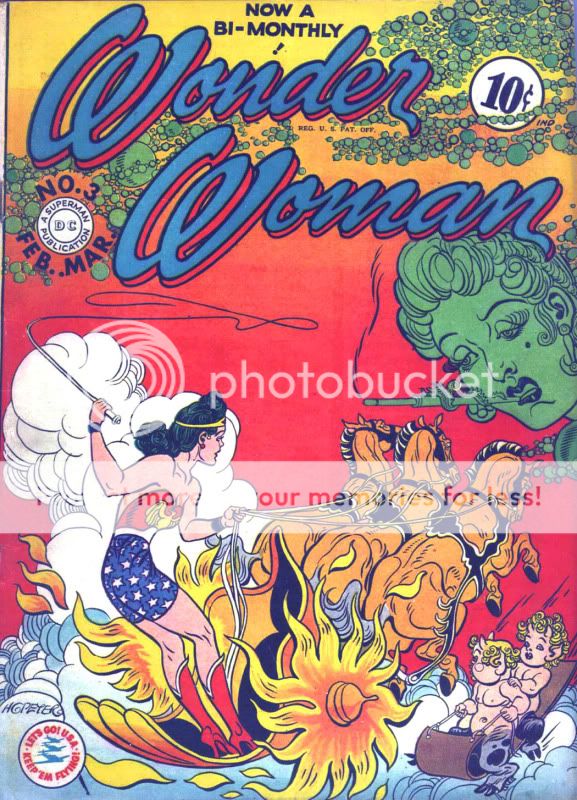
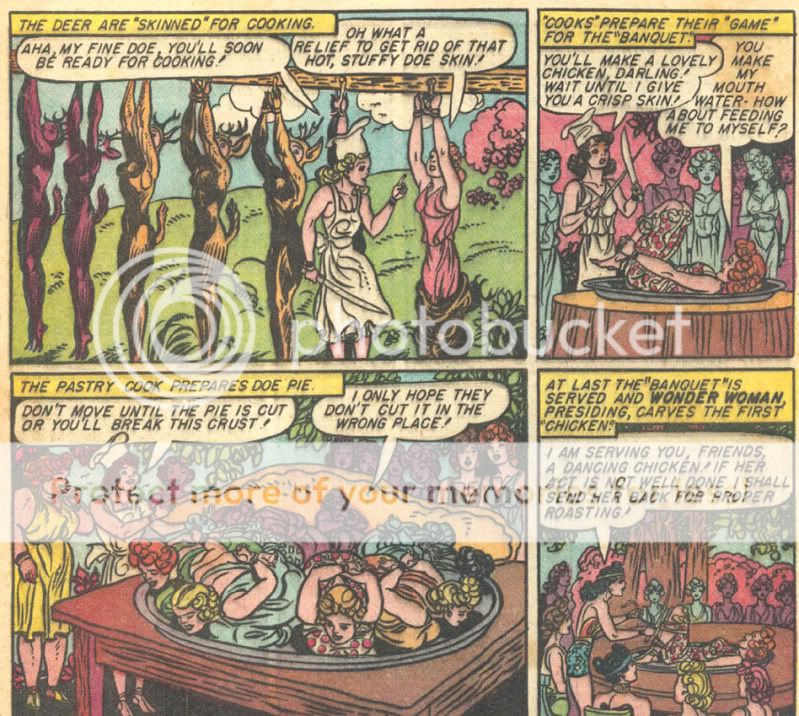
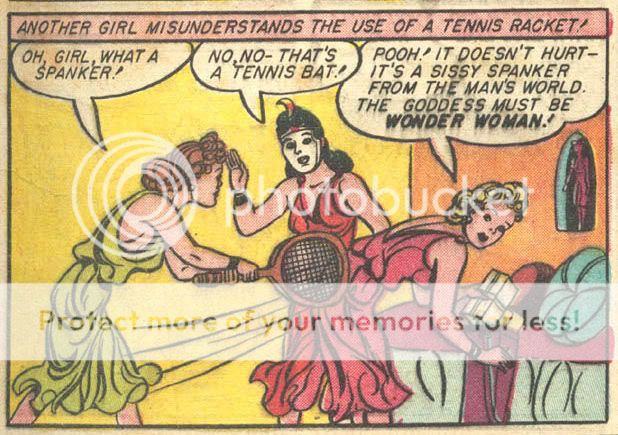
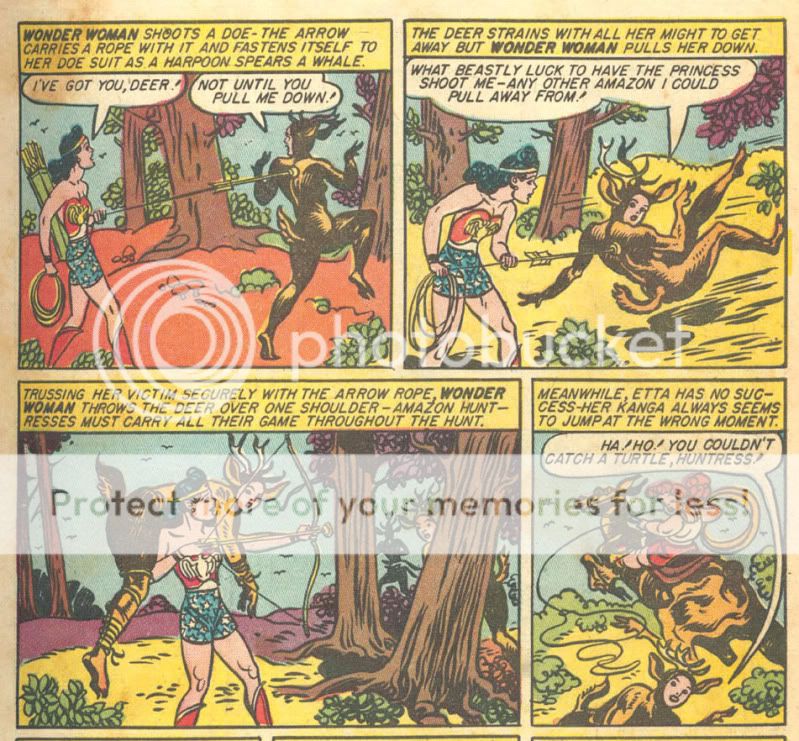
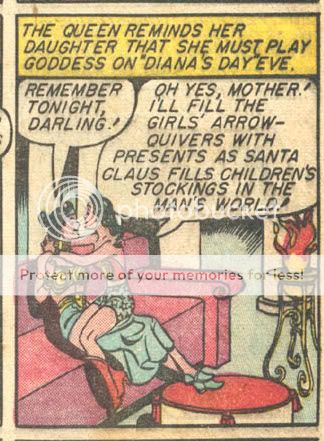
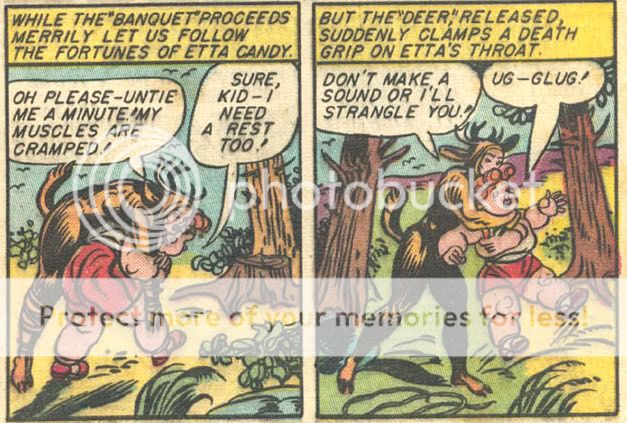
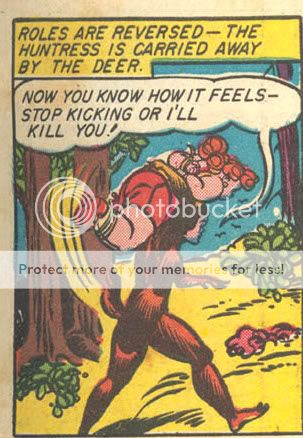
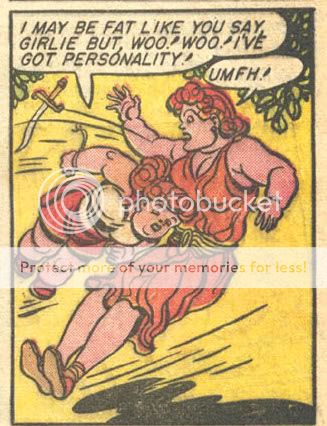

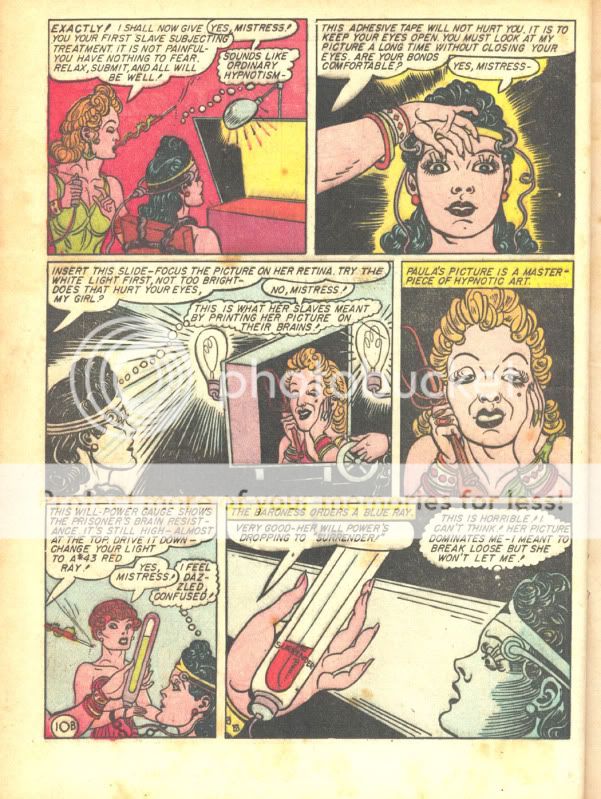
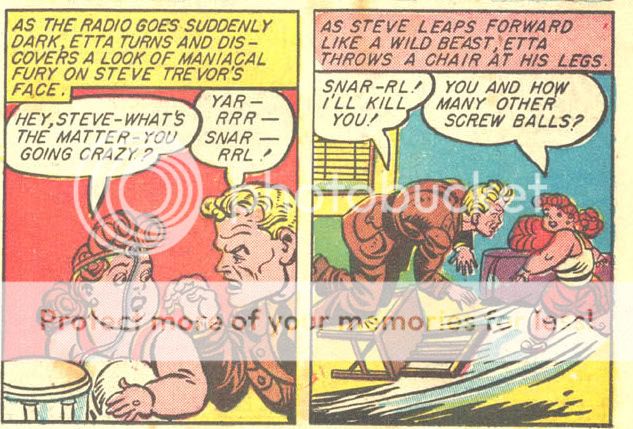
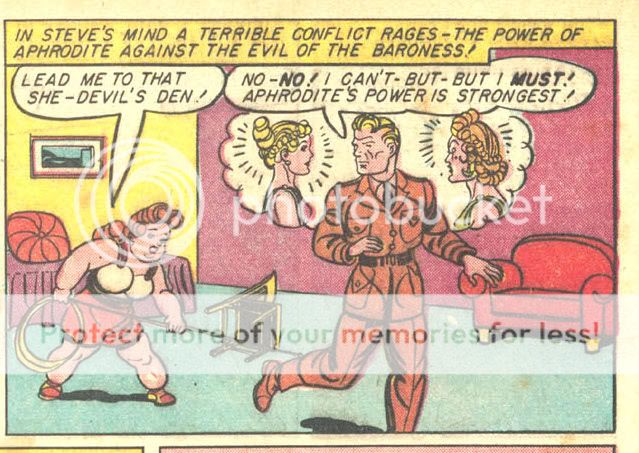
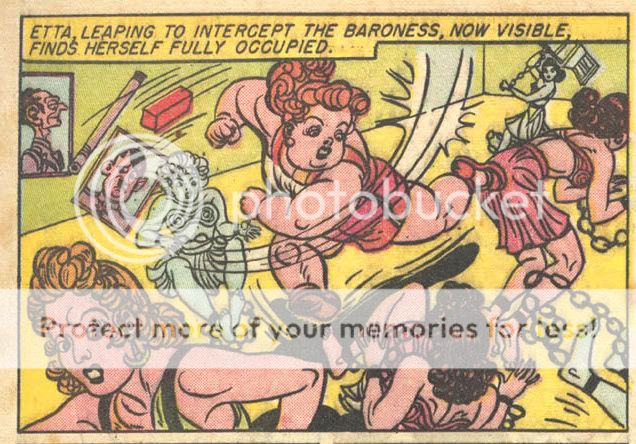
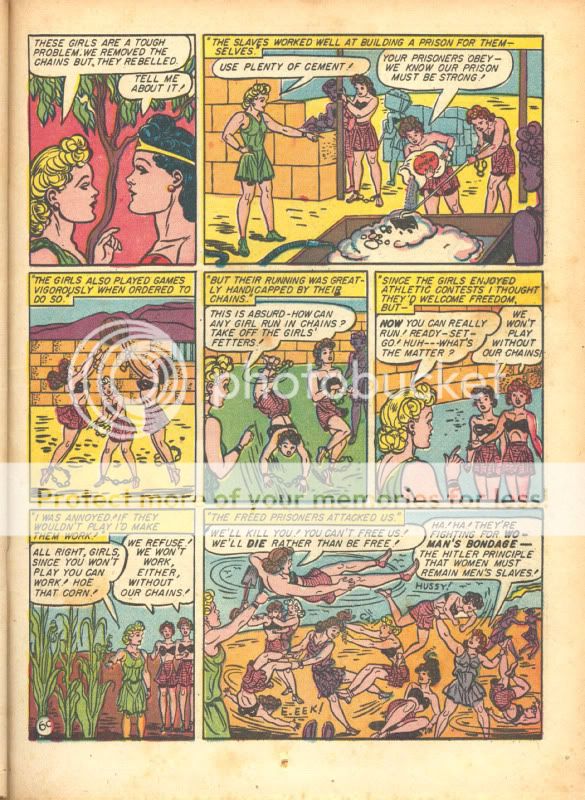
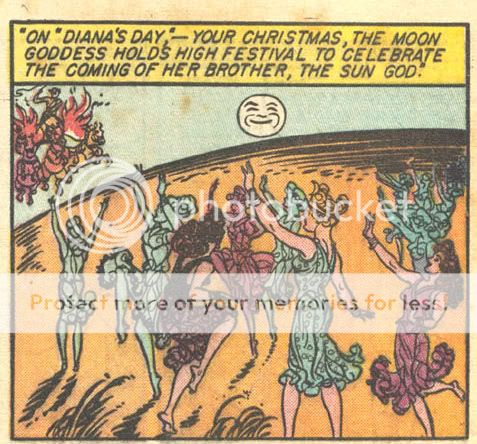
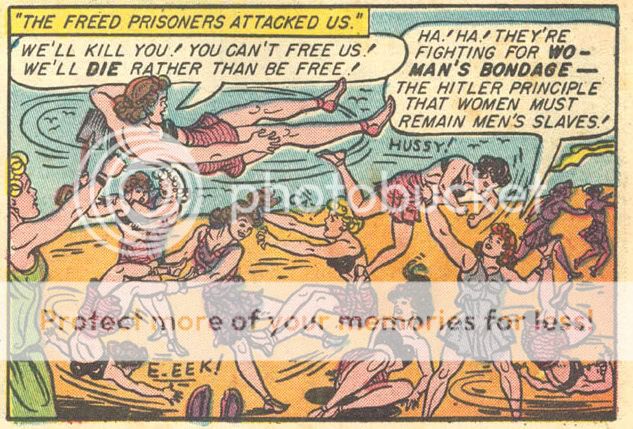
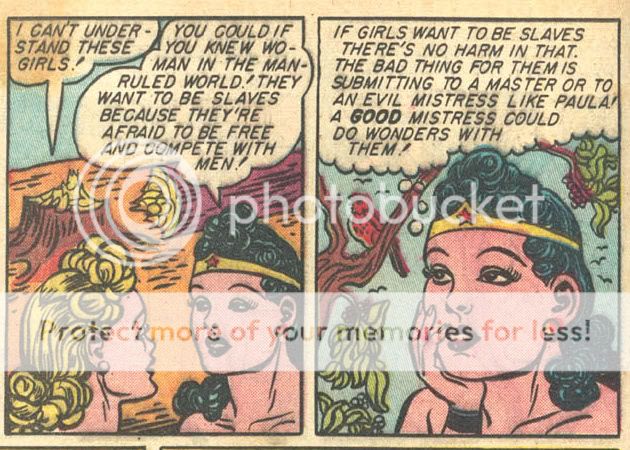
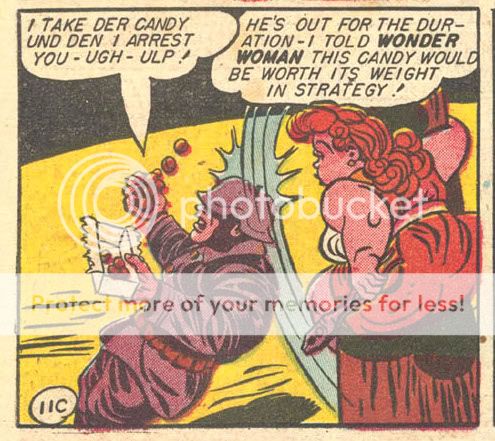

It seemed odd when you casually compared the Marston story to “Tabico’s” wank story from “The Erotic Mind Control Archive” at length, as if this were a generally recognized author of note. It’s a jack-off story by an amateur semi-anonymous writer from a porn site. Seems like writing a review of an episode of “Twilight Zone” and comparing it to a letter in Penthouse Forum. Just seems a bit distractingly wacky of an editorial choice. Threw me out of the essay. I enjoyed your description of the comic’s cover, though.
Fame and genre don’t necessarily have anything to do with whether a work is good or not…and Tabico’s a genius, damn it. I discuss why at more or less ridiculous length here.
Still, it’s probably not a bad idea to put that link in the body of the essay. I’ll go do that….
Maybe I’m just being a prude because reading that makes me have to imagine you finding that story while prowling the net with your dick in yer mitt. But that reaction is somewhat hypocritical given that I haven’t put much effort into avoiding the sly advances of Mother Fist and Her Five Daughters.
I’ll check yer essay on Tabico.
Comments on the essay you linked to were disabled, so here is my reaction to the first part of it:
The discussion of “The Thing” totally loses me. You seem to demand that the movie be about sex — and seemingly little else. If there are no women in the film about a small number of characters in an isolated military base in the ’80s, it has to be about homosexual desire? How can the movie be about homosexual panic when the thing they are afraid of isn’t even human? It has no sex. It’s death. Once it takes over someone, that person is dead, which is what they, and everyone else alive on this planet are afraid of: dying. The movie is about death, not sex. No one has time to even think about getting laid, because they are too busy trying to avoid being killed.
I thought it was unfair and earnestly politically correct early on in the discussion that you first take the movie, in which every single person dies, to task for sexism in not including women among the victims, but then take every other horror movie to task for using women as victims. Seems like the movie can’t win in your determination to find sexism and repressed homophobia in every frame of the film.
Well, you know…admitting aesthetic enthusiasms is always a somewhat revelatory and potentially embarrassing endeavor. I do think it’s pretty clear that Marston was getting off on writing the WW stories, yes? Since he seems to be a fetish artist, I think it makes sense to talk about him in relation to other fetish artists.
Hey Pinkhamster. I don’t take the film to task, at least not in the sense you mean. I think the film is brilliant. Carpenter’s movies are almost uniformly most interesting when he doesn’t use women. He’s got a ton of interesting ideas about how men relate to each other and why. Whenever he uses women, things tend to fall apart.
I don’t take every other horror film to task for having women as victims either, I don’t think. I’m interested in how gender works in the films. I talk about that at some length, but I’m not by any means arguing that Shivers, for example, should be PC, or any different than it is.
The Thing is certainly about death. But what kind of death? And why does its apocalyptic anxiety take the form of doubling, penetration, loss of bodily coherence? If it were just about death, why not have some guy just wander into the base shooting people? Surely that would be more realistic, and therefore more frightening if the point is simply “death.”
If you don’t think gender matters in horror film, I guess that’s your prerogative. Lots of folks disagree with you though.
Also…you’re conflating sex and gender. I argue that the Thing is about gender, not necessarily sex. (Shivers is more clearly about both.)
Glad you like the film, and sorry I’m misunderstanding what you’re saying and attributing hostilities towards the film where they don’t exist.
The most powerful visual image of “The Thing,” to me was when that one fellow’s discarded head sprouts legs and eye stalks and scurrys around like a trapped spider trying to avoid getting stepped on. How does that relate to gender? To me it’s a mockery of our humanity, comparing the human head — home to our intellect and personality and the part usually looked to first for cues of our emotions — to something that repulses us (not counting those who dig spiders).
I mean, I do poke fun at the film for its anxieties around homosexuality.
The head falls off during a scene in which the body also gives birth to its own head. It’s a scene of perverse male pregnancy (I talk about this at some length in the essay.)
The scene also features a very vagina-like orifice chopping off a man’s arms; very much a castration scene. And, indeed, a severed head and bodily discorporation in general strongly suggests castration and unmanning.
I’m pretty sure the Lasso of Truth became just about truth before the Perez reboot. I think it was in the 70s that the submission/domination subtext was gradually written out of the series.
Also, I’d happily read a book that consisted of nothing but correspondence between Marston and Gaines.
Hey Richard. Yeah, the lasso was certainly truthy before Perez; it’s a lasso of truth in the TV show for certain. I bet it was Kanigher’s fault, which would put it in the 60s, or even the 50s.
Pinkhamster; about the Thing being about fear of death — I think it’s actually about fear of life. What’s scary about the Thing is that it won’t die; it replicates itself infinitely. Death (by burning) is actually seen as cleansing or natural; the fear is that one will not die, but will replicate and become not man, or thing.
It’s also about paranoia; not being able to tell who is a man (which, as I said, maps pretty clearly onto homosexual panic.)
So, any bodily orifice is a vagina, and any body part that’s cut off is a castration? Seems like a self-fulfilling analysis. If you look for broad enough clues, you’re bound to find the symbolism you’re looking for. The thing that opens in the guy’s chest is a mouth. Mouths (and only the mouths of large predatory animals) are the things with teeth that can bite off appendages, not vaginas. Despite the work of Robert Mapplethorp, I don’t even know if it’s possible to get two hands inside a vagina at the same time. And penises don’t have fingers. Those things that the mouth ate were hands, not penises. If you’re willing to define any hole as a vagina and anything that goes into a hole as a penis, I guess you have a point. But one could just as easily say all holes are gas tanks and all nozzles are gasoline nozzles, and thus the movie is a metaphor for our fear of control by oil shieks.
Okay, I deleted those last two comments. Blogger, quit screwing with formatting!
What I said:
The thing that opens in the guy’s chest is a mouth. Mouths (and only the mouths of large predatory animals) are the things with teeth that can bite off appendages, not vaginas.The vagina dentata image is pretty common.
I’m familiar with that image. That image is a metaphor which compares the vagina to a a mouth. However the scene in The Thing is already a metaphor which compares the chest cavity to a mouth. It’s not a metaphor which compares the chest cavity to a vagina, because vagina do not have teeth or eat things.
John Carpenter never suggested that the movie was about oil sheiks. He did talk about it as an Aids metaphor, though. Obviously, directorial intention isn’t everything…but it’s not nothing either. I’m certain that Carpenter is quite aware of some of the sexual connotations here; he certainly deliberately included at least one scene which is very like a rape.
Also, as Bill says, the vagina dentata is very common — and the guy gives birth to his own head through a hole in his stomach in the same damn scene. Saying “it’s a mouth” may sound like you’re being more literal or no-nonsense or hard-headed…but think about what you’re saying for just a second. You say it’s a mouth. Is it?
No, of course not. It’s not a mouth. The movie isn’t real. People don’t have mouths in their stomachs with teeth that give birth to their own deformed heads. The orifice in his stomach isn’t a mouth and it isn’t a vagina, but it suggests both of those things.
Similarly, with castration. The point isn’t just arm=penis. The point is that castration is (especially in this movie) about fear of being unmanned, of losing bodily integrity and becoming not-man, or thing. It’s about being swallowed in a slimy, gendered, non-male viscous fluid that sprouts suggestive orifices and protrubrences (sp?) at will.
I mean, frankly, that’s why I like the movie. It has all this sexual/gender content that is funny and squicky and off-putting and weird and, I’d argue, profound. Take that away and you’ve just got…what? A fairly boring story about an animal that eats people? The banal observation that death is bad and scary? You say:
“To me it’s a mockery of our humanity, comparing the human head — home to our intellect and personality and the part usually looked to first for cues of our emotions — to something that repulses us (not counting those who dig spiders).”
Okay…but where does that mockery come from? What does it mean to be disgusted by bodies (which is what I’d argue is happening here, right?) Do you really believe that this disgust with bodies this obsession with bodily fluids and loss of bodily integrity, has no sexual implications or content?
about death, it’s been a long time since i saw the thing but i think what came across more strongly to me about the transformations in that movie was the violent loss of continuity, of self or soul or consciousness or whatever which is, if not precisely death, pretty close to my conception of death.
i definitely see strong gender/sex concerns in cronenberg, where there is often some ambiguous continuity of consciousness in (spite of) the transformations and at least for me that focus makes them much less horror movies. when i first saw the fly i was thirteen and i’ve almost viewed it as a straight up tragic love story. shivers is awesome. but i didn’t find it scary at all, actually found it weirdly and perhaps satirically utopian.
anyway, getting back to the thing, it’s been ages since i last saw it but it was the hoplessness of it that got to me. the transformations were cool but not particularly meaning-laden to me. when i see weird imagery i try not to think of it metaphorically. for me it was compelling enough in that it presented weird and imaginative ways to die horribly, and didn’t try to read any significant meaning into any of it.
for example, the thing mouth/vag-bite scene: honestly i was thinking “aaagggh loss of an arm!” when that happened and not “ick, this is highly suggestive of sex/penetration/castration!” i know i lack a strong ability reason flexibly but still… that was enough for me.
maybe you can conflate the two (sex/consumption). i think that could be illuminating in some but not all cases. i’d have to watch the thing again to know how i feel about that one.
this blog is pretty much my only exposure to feminist discussions of gender. it’s pretty much the only non-technical blog i read now too. keep it up, i love that there’s now pretty much daily content.
-David Alex
“That image is a metaphor which compares the vagina to a a mouth. However the scene in The Thing is already a metaphor which compares the chest cavity to a mouth. It’s not a metaphor which compares the chest cavity to a vagina, because vagina do not have teeth or eat things. “
Pinkhamster…metaphors are like dreams. It doesn’t always have to be one to one to one…and it’s a comparison of two things that aren’t alike. The chest cavity with teeth is not a metaphor for a chest cavity with teeth — it *is* a chest cavity with teeth (diagetically, anyway.) It’s *like* a vagina with teeth, and that is emphasized by the fact that it gives birth.
David…you might want to read my essay (linked in the post above.) I don’t talk a lot about consumption, but I do talk loss of self a lot, and how that ties into various gender fears and issues.
And glad you’re enjoying the blog!
“Similarly, with castration. The point isn’t just arm=penis. The point is that castration is (especially in this movie) about fear of being unmanned, of losing bodily integrity and becoming not-man, or thing. It’s about being swallowed in a slimy, gendered, non-male viscous fluid that sprouts suggestive orifices and protrubrences (sp?) at will.”
okay, maybe i misunderstood, you posted that while i was busy writing my reply, that’s much clearer.
still though, i mean, that thing is icky. it’s not icky because bodies are icky. it’s icky because it’s an icky body. kind of frustrating that we have to talk about it metaphorically (it meets my standard of ickyness because it resembles or suggests this or that other thing which i find gross) but i mean, i dunno, maybe it’s ickyness can be self-contained.
-David Alex
“that’s why I like the movie. It has all this sexual/gender content that is funny and squicky and off-putting and weird and, I’d argue, profound. Take that away and you’ve just got…what? A fairly boring story about an animal that eats people? The banal observation that death is bad and scary?”
There is no “observation” that death is bad. Drama is not an essay which makes philosophical “observations.” Drama is a simulation which places us empathetically in a hypothetical situation. The film shows us tense situations of people (and ultimately the entire human race) in danger which excite us through empathetic fear for the wellbeing of the characters in the film. I don’t need to amuse myself by adding a Mystery Science Theater commentary track full of my own riffs on sexual politics to enjoy Carpenter’s skill as a creator of dramatic tension through image and sound.
“drama is a simulation which places us empahtetically in hypothetical situations” huh? So you’re not a Beckett fan, then?
I mean, Carpenter’s imagery is certainly lovely, and the special effects are great. He’s a good story teller. But…you really want nothing from your art but “this happened and then that happened, and boy…that’s kind of scaaaary.”
As I said, Carpenter is willing to talk about this movie in terms of the AIDS epidemic. My point is…I’m having a conversation with the film, but it’s a conversation that Carpenter is engaged in…just as Shakespeare would be engaged in the conversation if I talked about the gender politics in As You Like It. I don’t see how you are doing Carpenter a favor by suggesting that he doesn’t have anything to tell us beyond “whoo-hooo! that’s frightening!”
Carpenter’s obsessed with gender and masculinity. It’s a theme that shows up in virtually all of his movies to one degree or another. If you’re not interested in thinking about what he has to say beyond giving you a thrill and some pretty pictures, that’s cool. But I happen to think that (at least in this movie) he’s a great artist, and great artists tend to be great in part because they put reality together in provocative and profound and thoughtful ways. Which is to say, technical skill is great, but I like content in my art too.
And *you* are the one who suggested that that film image was talking about death and bodies. You interpreted the film and its imagery, because that’s what responding to art is. Narrative is one way that you can engage with art, but it’s not the only way (or, you know, visual art would be meaningless.)
Hey Pinkhamster, I’m going to have to go do real life things for a while. I hope there’s no hard feelings; I like talking about the Thing, and it’s been fun revisiting it. I appreciate your taking the time to look at the essay. Take care!
I didn’t say it was talking about death and bodies, it shows death and bodies.
It just seems odd to me to claim that the last scene of the film is knowingingly winking that “why don’t we just wait here for a while? See what happens” is somehow “a classic come-hither line,” when these are two guys waiting to die from hypothermia. There is nothing innately sexual about sitting and waiting. People sit and wait all the time. You’ve totally injected sex into it, warped the meaning of the scene beyond recognition. Sex seems like the furthest thing possible from this moment. They are waiting to die. I’m not sitting there thinking they just made a sly gay joke. It seems like you’re talking at the film more than talking about it.
Well, I’m happy to have folks like The Thing for whatever reason, really. Take care.
Lets just wait here a while and see what happens.
All right, you’ve provoked me (as it were.)
The last scene is about waiting for death. It’s also about trying to figure out who is or is not a man. It’s about the relationship between the two men. That relationship is defined by paranoia, passing, and scoping each other out.
“I’m not sitting there thinking they just made a sly gay joke.”
That’s fine. It is possible that Carpenter is more interested in/attuned to issues of masculinity and gender than you are, though. Your point is basically “I don’t see it, therefore it isn’t there.” That’s exactly the sort of thinking that would get you killed if you were on that base, no?
It is possible that it’s not there and I don’t see it, true. However, I don’t think it’s possible that “why don’t we just wait here for a while? See what happens” is a “classic come-hither line,” as you claim, because I think I would have heard of it by now.
It seems to me that there is no way that anything in this film could be interpreted as *not* being about gender and masculinity under your critical scheme. How are we supposed to know when Carpenter is interested in anything other than gender issues and repressed homosexuality in any scene in this movie, when it’s in a line as neutral as that? Once an artist goes so subtle as to intend for us to know that “let’s sit here and wait” spoken by two men who have shown not the slightest sexual interest in each other means “why don’t you come up and see me some time,” (you say I’m confusing gender and sex, but a “come-hither line” is a sexual proposition, not a statement of gender identity), he’s going to have a hard time communicating anything other than gender messages, because we as the audience are apparently intended to find them in every corner, and are thus supposedly given license to find them everywhere, whether intended or not.
I once read the book “Subliminal Seduction,” in which the author demonstrated how the word “sex” was hidden in advertisements in magazines in order to get us to buy things. I believed him, and started finding it everywhere. It took me finding the word “sex” in the film grain all over photos I had taken and developed myself in my high school photography class to realize that I was finding things that weren’t there, because I was looking for something that could be found everywhere, regardless of whether or not it actually was.
Well, anyhoo. I’ll let you go about your work at this point and leave your comment boxes alone. There are fundamental disagreements about art between us and it doesn’t seem productive to continue butting heads.
Thanks for being civil, and I hope I’ve been. Sometimes I get carried away.
“I once read the book “Subliminal Seduction,” in which the author demonstrated how the word “sex” was hidden in advertisements in magazines in order to get us to buy things. I believed him, and started finding it everywhere. It took me finding the word “sex” in the film grain all over photos I had taken and developed myself in my high school photography class to realize that I was finding things that weren’t there, because I was looking for something that could be found everywhere, regardless of whether or not it actually was.”
You’ve seen Carpenter’s They Live, right? A paranoid fantasy about subliminal messages in advertising?
I’m not trying to interrupt the ongoing discussion here or anything, but I wanted to share my reaction to the Wonder Woman story you’re talking about here, which is “Holy shit! This is fucking insane!” It can be easy to get accustomed to this sort of thing when you’re exposed to it regularly, but wow, it’s really nuts. Women dressing up as deer, being hunted and pretending to be cooked and eaten? I can’t believe this even exists.
Sorry that I don’t have anything more profound to say than that, but your look at these stories is worthwhile just for exposing their batshit nature. Of course, you do much more than just point it out and say “Isn’t it crazy?”, which is why these posts are so awesome. Keep it up!
By the way, that cover is definitely pretty incredible. I especially dig the flaming wheels and the lumpy, expressive linework on the horses. I used to kind of pooh-pooh this sort of Golden Age comics art, seeing it as old-fashioned and ugly, but I’ve totally come around, at least on HG Peter.
Hey Matt. Thanks! Yeah…I don’t think I’ve become jaded yet. I mean, when I read through them, I do keep saying, pretty much exactly, “holy shit!” The deer costume thing — and then they tie them up and pretend to eat them…what can you say? It’s just unbelievable.
I think Peter is really special as far as Golden Age artists go. I haven’t seen a whole lot of folks from that period (or any period, for that matter) who are either as skilled or as idiosyncratic.
John Carpenter’s hiding subliminal messages in his work like the aliens in “They Live,” I guess this counts as our 20-minute back alley brawl over whether or not I put on the sunglasses.
Noah,
The Wonder Woman cover gets better. Those chubby kis on the sled, they’re not cherubs. They’re saytrs.
You might be interested to know that the word panic comes from Pan, as in the fear that Pan the saytr might rape you in the woods if you went out alone.
Pink — yes, I think it does. Complete with homoerotic subtext.
Oh my God, Anon. Good eye. That does indeed make it better.
The last issue of Wonder Woman totally written by Marston was issue 28. The transition is pretty obvious, because issue 29 has 3 or 4 unrelated 10 page stories instead of a single long story, and has maybe 1/10th or 1/100th the bondage, 1/1000th the wacky imaginativeness, and IIRC, there is also a sudden disappearance of Etta and the Holliday girls.
I know you’re not doing Sensation comics, but the Marston was the wroter for all WW stories there through Sensation 76, and is also thought to have done the WW story in Sensation 82. The best reference I know of for this kind of information is http://www.dcindexes.com/database/creator-details.php?creatorid=32
Oh, and Marston was also responsible for most but not all of the WW stories in Comic Cavalcade through #22.
Bless your heart, Glaurung. Thank you.
If I remember right, a lot of stories credited to Marston were not actually by him. He’d farm the work out to his kids so they could make some money. Don’t know how that affects your calculations; it seems likely enough their stories might be just as nutty, or that he put in some pervy, crazy shit before sending the script on to headquarters.
Anyway, I read it in the Les Daniels book on WW. It’s a good account of the character’s publishing history.
I was trying to find out what the last Wonder Woman story Marston wrote was, so thanks to the person who came up with that information. Actually, I was trying to find out if he’d written #28, which is dated after his death, but ends with the phrase “obedience to loving authority” which was a pretty strong hint that Marston wrote it.
On another subject, the WW/Steve Trevor relationship is one of my favorites in comics. I love the way he always calls her “angel” (You don’t see Superman and Lois Lane regularly using terms of endearment for each other), and he once give up super-powers because she didn’t like him any better when he had them.
There are similarities with my second favorite superhero romance: Peter Parker/Gwen Stacy. In both cases, the love interest was first destroyed as a character and then killed off because, after the creator left the book, later writers didn’t necessarily have a clue about how to write for a couple who were in love with each other.
Hey Fred. I have trouble thinking of the Steve/WW relationship as an actual relationship in any but the most notional sense…but maybe it’ll develop more as I blog through the run….
Sorry to report that the “I am one of those odd, perhaps unfortunate men…” quote was not written by Marston but was written to Gaines by a reader (a sergeant in the 291st Infantry). See the Les Daniels Wonder Woman book for the details.
Ah well…I need to get that Daniels book. Thanks for the info!